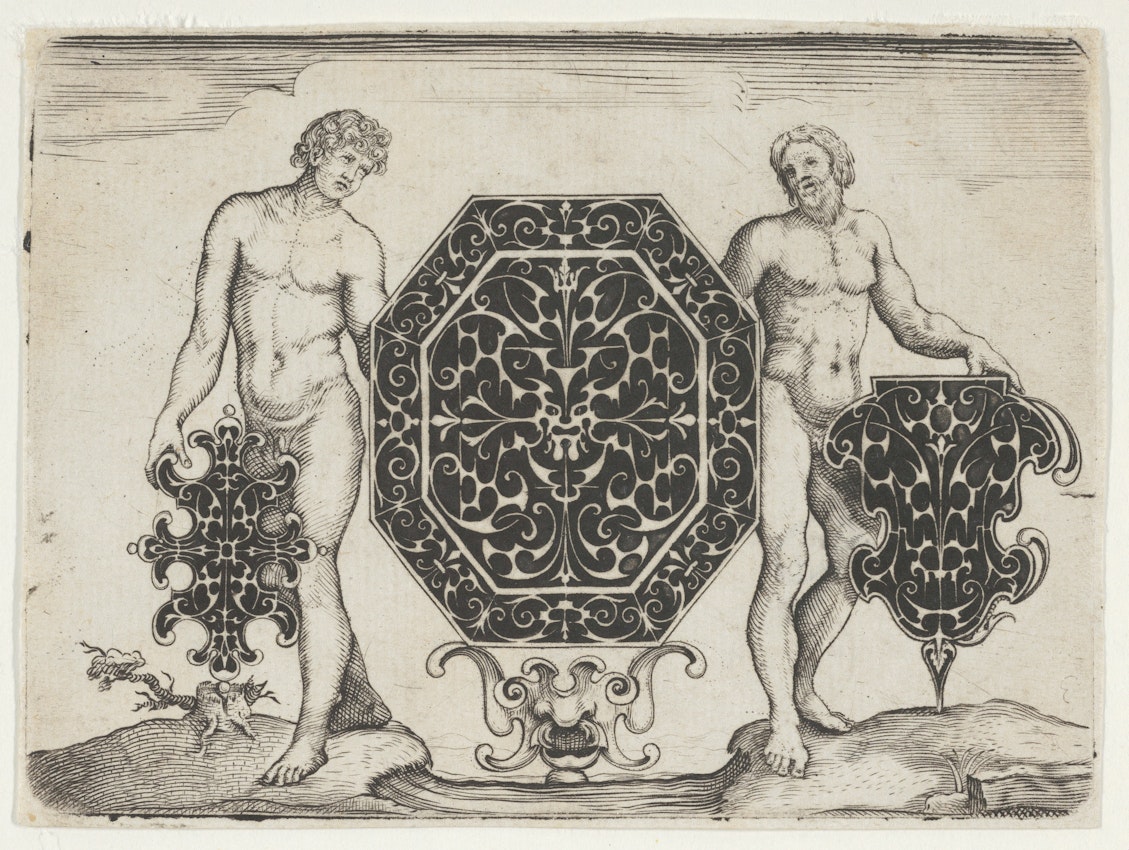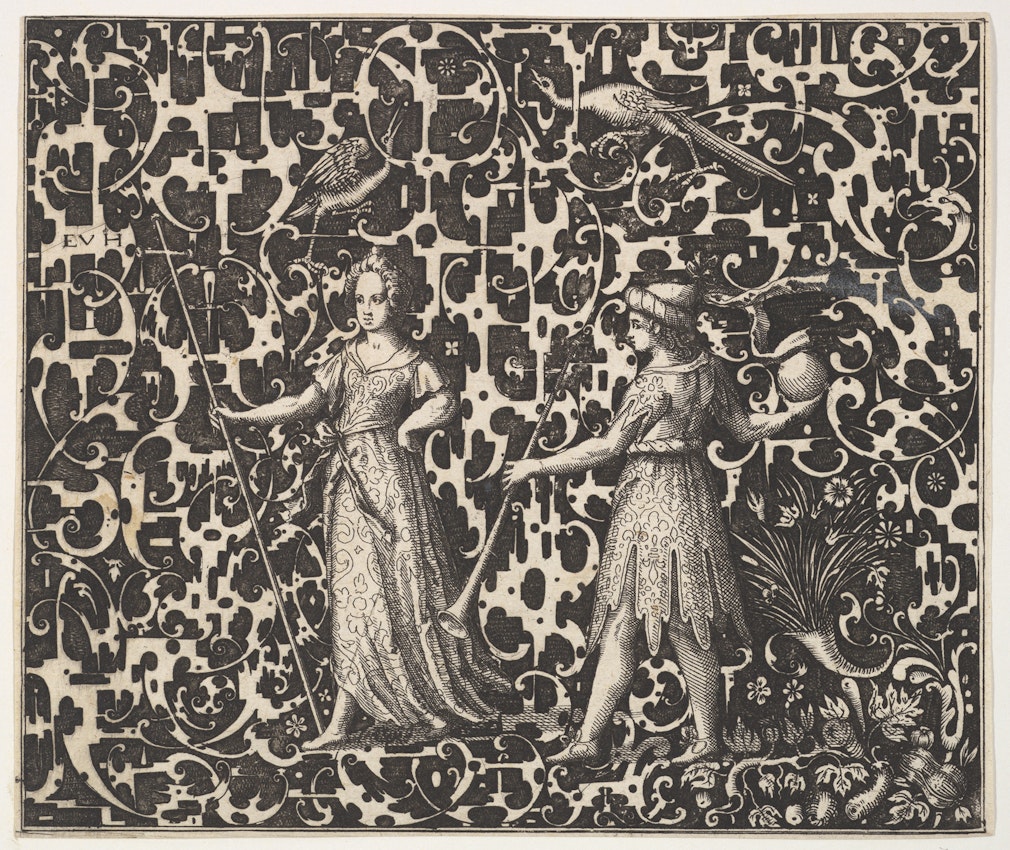
Paper Gems: Early Modern Blackwork Prints
Early modern prints are recycled waste products of everyday life. Paper was fashioned from soiled and tattered linen, which was boiled and beaten into pulp, then strained and dried in sheets. Ink was an admixture of lampblack or soot blended with oil. Rags and grime thus became the material basis for print media, once wrought through the printmaker’s resurrective craft. As printmakers of this period continued to discover, this act of applying ink to paper with a printing matrix and a press could be accomplished via an astonishing multitude of techniques, some quite esoteric.
One unusual technique, called blackwork, resulted from the adaptation of an enameling process known as champlevé. In traditional metalwork, champlevé entails filling shaped voids in a metal object, such as a brooch or box lid, with a powder of colored glass and sometimes, metal. The object is then heated to melt and bind these fillings, and, once cooled, polished until smooth and an image or pattern becomes crisply legible. To create blackwork prints, shaped voids are gouged into a copper printing plate (rather than a piece of jewelry or decorative object) and filled with a concoction of thick ink (rather than colored glass). When pressed onto paper, the inked voids print areas of pure black that contrast with the unprinted paper; the resulting image was often an intricate pattern or lacy ornamental motif. Artists who made these prints frequently combined blackwork with the linear compositional elements of traditional burin engraving.
Blackwork prints often signaled explicitly the technique’s origins in jewelry design. The earliest known print of this kind is a design for a ring and bezel. Insect and flower motifs are common in blackwork prints, as they are in jewelry. Many of these prints present designs for hypothetical objects like pendants, brooches, or earrings. As they imagined these objects that could be, but as yet did not exist, blackwork engravers were determined to make their own works — paper prints — precious and full of visual interest. The prints of Jean Toutin (1578–1644) and Elias Holl II (1611–1657) depict pendants and gemlike motifs suspended in the air above figural compositions that seem to bear little logical relation to them. Their jewelry designs and arabesques float over scenes of minimal narrative: harvesters pushing wheelbarrows; strolling couples. These curious juxtapositions anticipate department store window displays that appeared centuries later, where scenes of light narrative suggestion, in miniature, become backdrops for salable items. One printmaker, Giovanni Battista Constantini (active 1615–1628), understood that sex sells: in Octagonal Case and Two Other Motifs Held by Ignudi (1622), the contours of two blackwork patterns brush suggestively across the genitals of the nude male figures presenting them.
 Scroll through the whole page to download all images before printing.
Scroll through the whole page to download all images before printing.In addition to functioning as design proposals, these printed motifs could also manifest more purely as compositional experiments that toyed with the pictorial elements of scale, perspectival space, and contour. As Madeleine Viljoen suggests, the blackwork process itself provided specific content to many of these prints, invoking the air and gusts that produced the soot of printing ink and the creative spiritus of engraving. In one print by Toutin, for instance, a blackwork pendant hovers above a furnace tended to by a goldsmith and an assistant who clutches bellows.
The production of blackwork prints spanned only a few decades, from the mid-1580s through the 1620s. Shifting tastes in fashion and ornament are the commonly understood causes of blackwork’s decline, but that does not explain why these engravers were either unsuccessful or uninterested in adapting blackwork to other types of imagery. Perhaps blackwork was too bound up in increasingly out-of-vogue designs for audiences — and makers — to conceive of the labor-intensive technique as fit for anything else. Nevertheless, for a time, these prints’ creators appropriated both the design principles and craft techniques of jewelry-making for graphic art, and in so doing, created objects of virtuosity and whimsy.
Esaias van Hulsen, blackwork print with animals, 1617 – Source
Esaias van Hulsen, blackwork print of Apollo sitting with his lyre against a leafless tree, 1617 – Source
Esaias van Hulsen, blackwork print with a jug in the middle, 1617 – Source
Etienne Carteron, title plate with blackwork motifs from a series of blackwork prints for goldsmiths’ works, 1615 – Source
Esaias von Hulsen, ornamental print with blackwork and two possibly allegorical figures, ca. 1615–20 – Source
Etienne Carteron, blackwork print with a bezel supporting grotesques above three smaller bezels, from a series of blackwork prints for goldsmiths’ work, 1615 – Source
Hans de Bull, blackwork print with a row of seven vertical fillets below a row of three-pronged motifs and circles, 1592 – Source
Hans de Bull, blackwork print with a large bezel design at centre, 1592 – Source
Hans de Bull, blackwork print with two vertical panels flanking an oval at centre with four small circles, 1592 – Source
Noël Rouillard, blackwork print of lunar-shaped ring bezel and grotesque figures, ca. 1620–30 – Source
Giovanni Battista Costantini, blackwork print of nude figures holding an octagonal case and two other motifs, 1622 – Source
Noël Rouillard, blackwork print of concave lozenge-shaped panel and grotesque figures, ca. 1620–30 – Source
Mathais Beitler, blackwork design for goldsmith work featuring a hunter and a fisherman, 1612 – Source
Andreas Gentzsch after Mathais Beitler, blackwork design for goldsmith work with a putto, birds, and insects, 1616 – Source
Andreas Gentzsch after Mathais Beitler, blackwork design for goldsmith work with satyrs and meanads, 1616 – Source
Jean Toutin, plate from blackwork ornament designs for gold- and silversmiths, 1619 – Source
Claes Jansz. Visscher after Hertzog von Brin, blackwork print with birds, insects, and fruits, ca. 1620 – Source
After Adriaen Collaert, print of Mercury in a decorative frame with grotesques, ca. 1600–30 – Source
Elias Holl, II, January, ca. 1635–50 – Source
Elias Holl, II, May, ca. 1635–50 – Source
Elias Holl, II, September, ca. 1635–50 – Source
Jean Toutin, blackwork print of jewellery design with lion's head, 1619 – Source
Jean Toutin, blackwork print of design for a beetle-shaped pendant – Source
Jean Toutin, blackwork print of design for a turtle-shaped pendant, 1618 – Source
Jan 30, 2024













